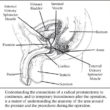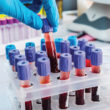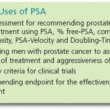Looking At Something New

QUEST has reported often about the need to find a way to distinguish aggressive from non-aggressive prostate cancer in the diagnostic stage.
So far, the search is on but the answers are elusive.
Now, researchers at Northwestern, using samples from Dr. Catalona’s post radical prostatectomy patients, have reported on a new biomarker, aPSA, for measuring the aggressiveness of prostate cancer at the diagnostic stage.
Their discovery involves the enzymatic activity of PSA (aPSA) in prostatic fluid.
Enzymes are proteins that speed up chemical reactions in cells. The enzyme is not changed or destroyed in the process. While a cell contains thousands of different types of enzymes, each is specific to a particular chemical reaction.
Using post radical prostatectomy samples, the researchers found that patients with the least amount of aPSA had the most aggressive prostate cancer.
In fact, the enzyme activity of aPSA in prostatic fluid was inversely proportional to the disease stage of the post operation prostate sample biopsy.
What the findings could mean is the development of a new tool to aid doctors and patients in treatment decisions.
For example, the pilot study results suggested that 22% of the patients diagnosed with non-aggressive prostate cancer in the pathology report after the prostatectomy could have averted or delayed the operation if aPSA had been used in the diagnosis.
Assessing Aggressiveness
To the knowledge of the researchers, this study is the first to assess the association of prostate cancer aggressiveness with enzymatic activity of PSA in prostatic fluid.
This pilot study shows an unprecedented discrimination between clinically aggressive and non-aggressive prostate cancer.
It means that this relationship could, with further study, establish a biomarker threshold to guide when clinical treatment should occur and when it doesn’t appear necessary or could be postponed.
Even more, monitoring this aggressiveness biomarker could be used in patients under active surveillance, potentially eliminating negative outcomes that have been observed with delayed treatment in this population.
These researchers used prostatic fluid directly from radical prostatectomy specimens, an origin that would not be useful in the diagnostic process. But there are other clinical methods to obtain prostatic fluid samples earlier by massaging the prostate or by catching urine after a digital rectal exam.
Continuing Studies


The researchers hope to continue their studies in two areas:
- Including radical prostatectomy samples from prostate cancer patients with intermediate aggressive cancer to see if aPSA can have a broader use and
- Using samples of clinically expressed prostatic fluid or post-DRE early catch urine to confirm that their findings are valid for clinical samples as well as post operation samples.
After additional studies on this earlier retrieved prostatic fluid, researchers will know if aPSA is truly the revealing marker they believe it to be.
Such a test could complement existing screening tests and potentially reduce over-diagnosis and overtreatment of prostate cancer.
It could also prevent under-diagnosis of patients, revealing which men are not suitable for active surveillance and also which men might need careful watching after initial treatment.
It would give much needed information in the diagnostic stage.
While no results can be used immediately, the findings speak to ongoing research efforts in the “must find” evidence for distinguishing aggressive from non-aggressive prostate cancer at time of diagnosis.
This study, its formal findings and methodology, is in the process of being submitted to peer reviewed research journals.
from study: PSA Enzymatic Activity: A New Biomarker for Assessing Prostate Cancer Aggressiveness by Michael J. Ahrens, Paul A. Bertin, Edward F. Vonesh, Thomas J. Meade, William J Catalona, MD; and Dimitra Georganopoulou.
PSA Enzymatic Activity: A New Biomarker for Assessing Prostate Cancer Aggressiveness











